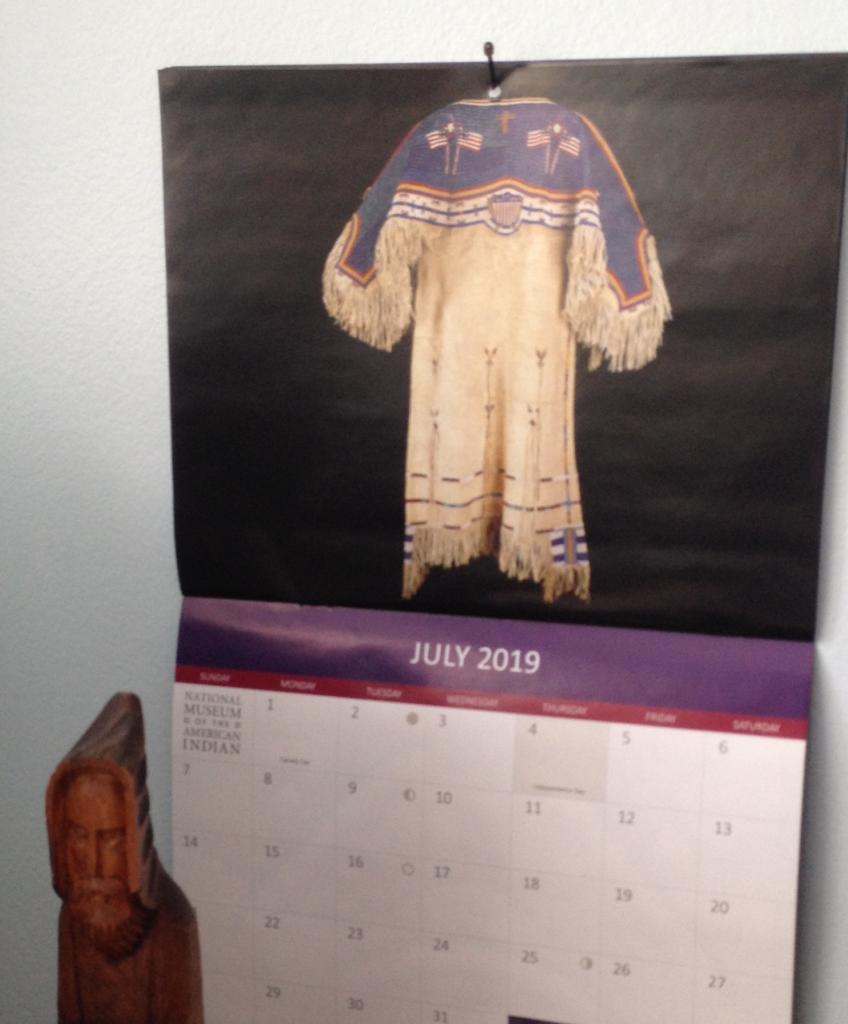Indigenous and Immigrant
Hum this to “America the Beautiful.” It’s my favorite line from Miriam Therese Winter’s version of this classic: “Indigenous and immigrant, our daughters and our sons, O may we never rest content till all are truly one.”
I am inspired to write about “indigenous” by the July page in the calendar of the National Museum of the American Indian – which stunned me. So beautiful. So perfectly designed. So complicated.

Turning the page, hanging it up, staring at it next to my desk, I think of all the contradictions it embodies. A deerskin dress in this era of animal rights, but in its time continuing the native practice of honoring, reverencing the animals who provided their whole bodies for the people.
A dress with American flag bead decoration made by women about 1910. Native Americans would not be guaranteed the right to vote in federal elections until the Indian Citizenship Act of 1924 – and prohibited from voting in some localities and states until the 1960s.
And, what you are more likely to know, before women got the right to vote in 1920.
Citizenship is not the all of it, however. Patriotism expressed through military service is notable in Native American iconography, though I can find nothing explicitly military in this dress.
On Independence Day (“Stories of America”) Marty Moss Coane on Radio Times talked with David Treuer, an Ojibwe from Minnesota. I’ve read many reviews of his important new book, The Heartbeat of Wounded Knee: Native America from 1890 to the Present; I will have to get one of my book clubs to read it! He challenges the “tragic narrative of native folk” with a complicated understanding of his reservation, Leech Lake, and even the boarding schools. When I taught, I stressed that Indians survived and that genocide is too simple; this book seems to expand that narrative from a native perspective.
What I want to focus on here is the patriotic commitment of Native Americans. Treuer says that joining the army helped Indians advance in the 20th century. A third of Native American males served in World War II. Treuer explains why they volunteered at such a rate: again, complicated. It was a real job in an era when jobs were hard to get for Indian men. Ceremonial positions were limited to combat veterans: the respect for warriors is a deep tradition in native cultures. Finally, these men and their communities saw themselves as American; they were deeply patriotic and wanted to represent their tribes in the battle for the country and for world freedom.
How does this relate to women’s ordination? I think of the service of so many women in the institutional church. The church is OUR country; we wear the battle scars of exclusion and even ridicule. Will we gain our freedom, exercise our leadership, inside — or only on our own reservations? Certainly we have joined together across many previously “tribal” lines, as Indians did in the schools and then in small towns and cities where many settled.
The most surprising aspect of this interview is Treuer saying that Nixon was “arguably the best president for native people in the last fifty years. He ushered in the best policy for Indian people: tribal self-determination.” Nixon saw Indians as “gifted and intelligent people who understand what is best for them.” Maybe looking back fifty years …
This is my transition to “immigrant.”
What can I add to the images we all see, every day on the news? The people I know who live near the border — and probably many of us — are doing all they can to ease the suffering, which has been brought to fever pitch beyond our ability to even imagine. Perhaps there will be an unexpected Nixonian resolution …
What I can add is my favorite verse of Katherine Lee Bates’s “America the Beautiful.” Published after her first version, in 1911, it is not always sung, but I have always felt it should be:
O beautiful for pilgrim feet
Whose stern impassioned stress
A thoroughfare for freedom beat
Across the wilderness.
America! America!
God mend thine ev’ry flaw,
Confirm thy soul in self-control,
Thy liberty in law.
If I ignore the Manifest Destiny implications of the first part of this verse and see it, rather, as freedom for Native Americans and Latinx who populated the West (which I admit is a stretch), I can sing out the end really loud. Self-control and law are the foundations of American liberty.

One Response
Unfortunately, the current administration in Washington DC is a patriarchal abomination. In the church, we should not have any false hopes that the Amazonian synod will seriously consider the ordination of women, but perhaps it may serve to raise awareness about the human dignity of indigenous people and migrants.